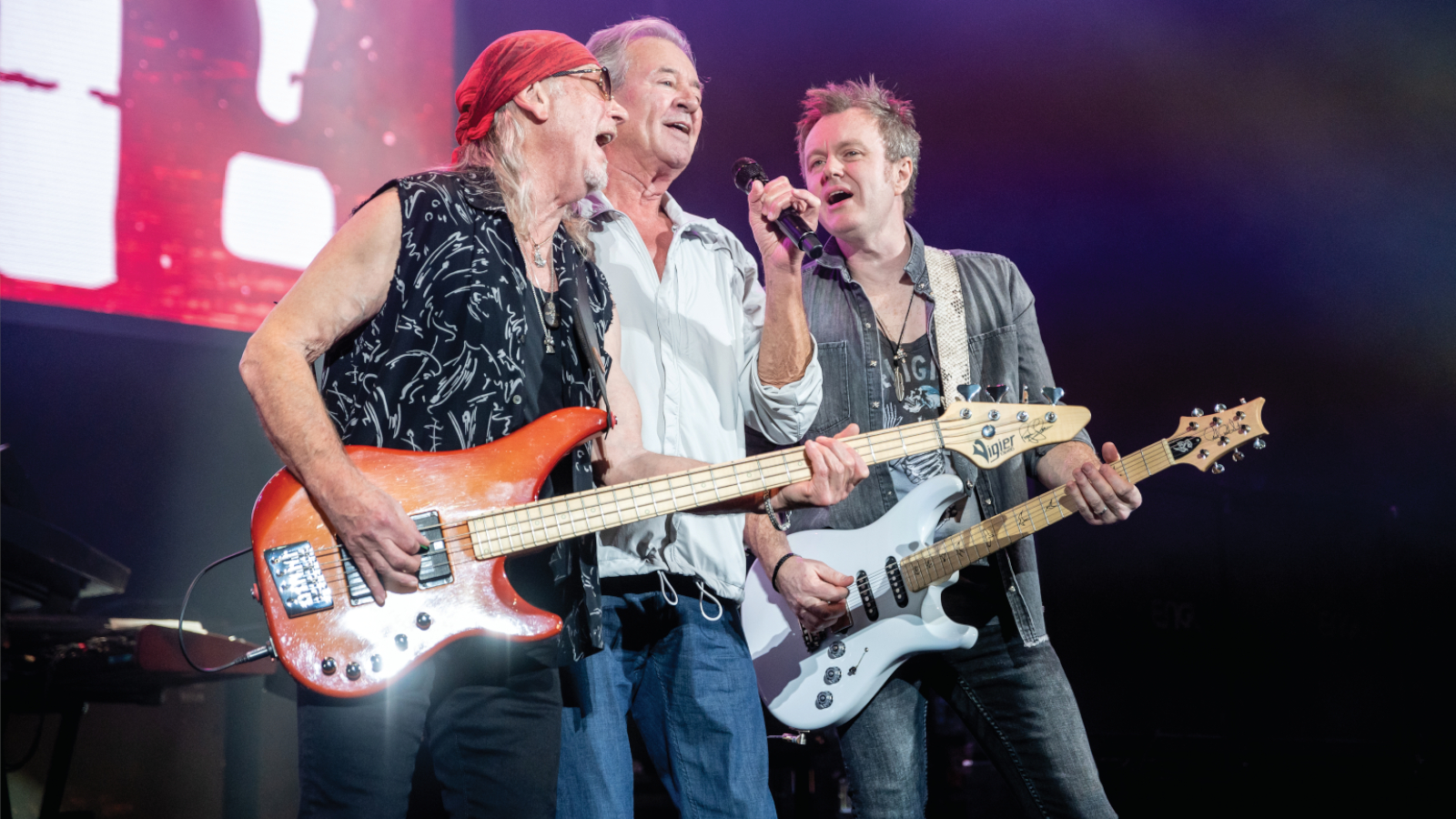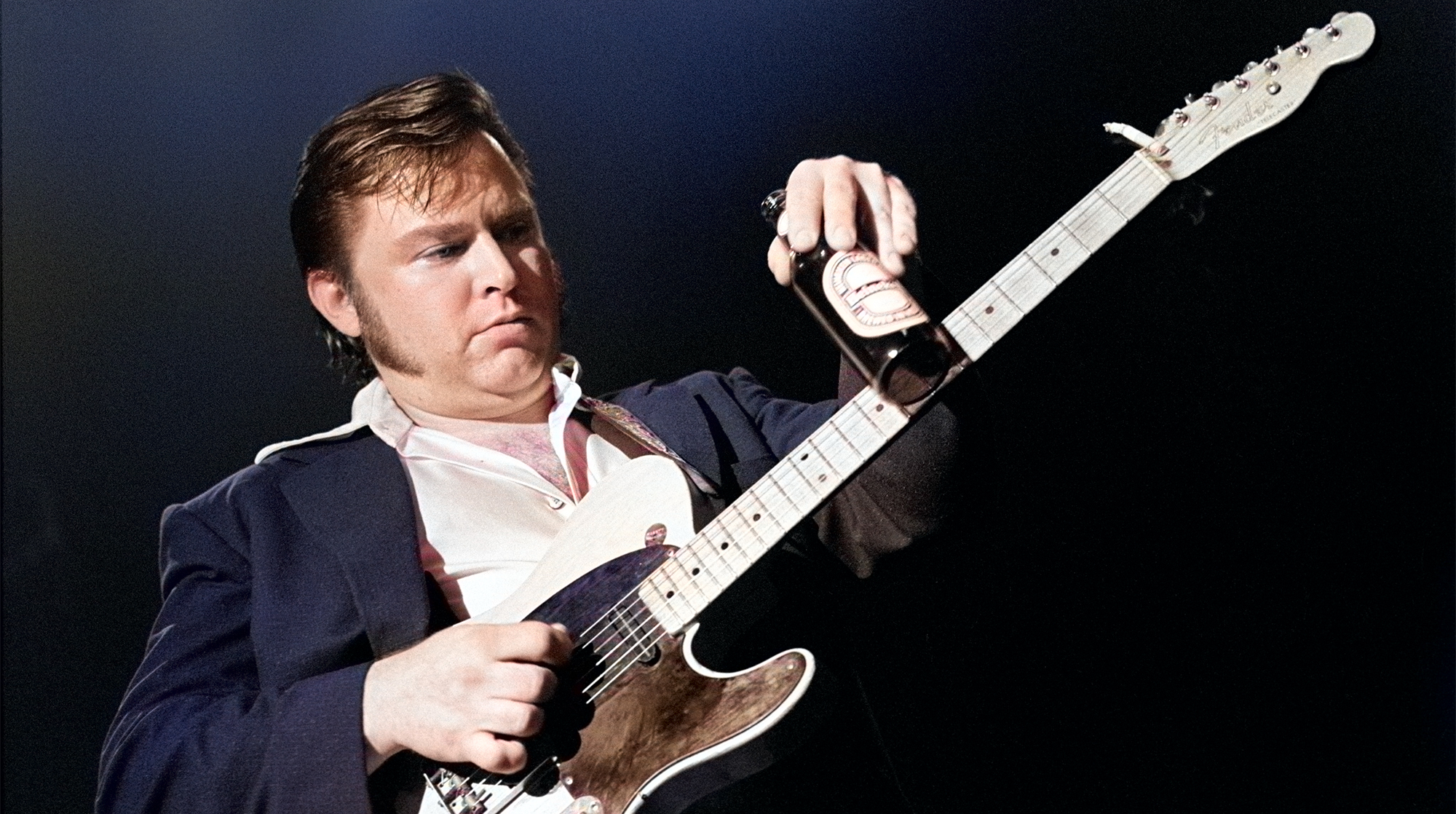
No gaff tape marks on the stage are necessary for Simon McBride – he always remembers where the sweet spot is. Alone under the lights for his big guitar cadenza each night with Deep Purple – and just after kicking on a Tube Screamer to make his white-hot electric guitar tone a few degrees hotter – he moves to that invisible X, hits a single note high up on the fretboard, and, with zero vibrato, gets it to sustain infinitely. When a shimmering overtone emerges from within the sound, the endless note becomes all the more prismatic. It grabs your ears the way a laser beam shooting up into the night sky attracts your eyes.
It’s an old trick, but, after watching McBride do it flawlessly at 16 different arenas all over Europe last fall (I was playing with the support band, Jefferson Starship), I can report that I’ve never seen anyone do it more hypnotically. It’s mesmerizing. Rather than seeming gimmicky, it comes off as heartfelt and part of a grander musical statement.
Next, McBride suddenly jumps up to a high-altitude F-major scale pattern, and, starting on the highest A on the highest string, blazes down an octave and a half of the shape as fast as possible, repeating the dazzling maneuver again up a half step, and then again up another half step, and so on. The notes whiz by faster than tracer bullets. It’s thrilling to experience, and it incites roars of delight from each new audience.
Standing at the monitor board after taking in McBride’s many guitar solos each night, Donny Baldwin – the veteran, multi-Platinum drummer in my band – turned to me and said, “Damn, that dude plays with so much emotion!” I agree. Whether McBride is playing slowly or quickly, I still feel each note. If you still think of Steve Morse as “the new guy” in Deep Purple – even though the brilliant Dregs guitarist’s tenure in the iconic rock band was, at 28 years, far longer than that of founding guitarist Ritchie Blackmore – you’re forgiven. There may still be a few guitar fans who haven’t yet heard that Morse announced his retirement from Deep Purple last summer to help his wife, Janine, through ongoing chemotherapy treatments as she confronts stage IV cancer.
The new new guy is Simon McBride. Hailing from Belfast, the Irish guitar hero was already established before joining Deep Purple, with multiple solo albums and videos released under his own name. (Want to hear a spectacular fuzz guitar break? Listen to McBride engage his Vahlbruch Octavia pedal on “Kingdoms,” from his latest solo album, The Fighter.) McBride had also proved his worth to the Purple camp by touring and recording with two legendary members of the band, keyboardist Don Airey and singer Ian Gillan, long before they ever knew they might need to enlist him for Purple.
“Two-thousand-twenty-two was weird but also wonderful,” McBride says of the year he officially joined forces with the British rock titans. “At first I was sort of subbing in for Steve, but when they said he was stepping away and asked me to join, I said, ‘I’ll think about it.’” He laughs. “No, I actually immediately said, ‘Yes.’”
Of all the guitarists you’ve seen perform in your lifetime, who most blew you away with the sheer level of emotion in their playing?
All the latest guitar news, interviews, lessons, reviews, deals and more, direct to your inbox!
It’s got to be Gary Moore. Gary was a massive influence on me, starting when I was a kid. Obviously, he was from Belfast too, but when I was about 10 years old and my dad took me to see him, it inspired me to go, “I want to do that.” He played with such aggression and passion, and I think from learning all his stuff over the years it’s a natural thing that comes out in me, too. I have to thank Gary for that.
There are so many Gary Moore songs that a lot of people don’t really listen to, because he was so popular for his blues thing, as that’s what really broke him and made him massive. But people forget the heavier stuff, like Corridors of Power. He has so many brilliant albums, all of them full of great riffs.
What’s your philosophy on getting a kick-ass hard-rock guitar sound in an arena?
It’s about having teeth. I do have a lot of modern gadgets like, for example, the [Neural DSP] QuadCortex, which I use in the studio and think is great. But live, I’m that old-school kind of a player who is used to having a fire-breathing dragon – a wall of Marshalls – shouting at me.
I started using Engl stuff when I joined Purple, and it’s great. I used Steve [Morse]’s heads for a while, and they’re great, but while that amp suits Steve, it is a bit more compressed and high-gain than what I prefer. Plus, there are too many buttons on it for me. I’m a very simple guy. I’m like, “Just give me my bass, mid, treble, gain and volume.” Done.

So the guys at Engl tweaked a head for me to have more aggressiveness, especially around the high mids, because that’s how a guitar frequency cuts through. Once you start sucking the mids out of your sound, you lose the guitar, whether you’re playing a small club, an arena or a stadium – especially in a band like Purple, where you’re competing with [Airey’s] Hammond running through two Leslies and a Marshall, which has a similar frequency range as your guitar.
One modern development, though, is that I now run my stage rig in stereo, and for that I blame COVID, because for two years I was sitting in my home studio playing in stereo through my studio monitors. When live gigs started happening again and I plugged in my mono setup, I was like, “This is not gonna work.” [laughs] I now run a simple left/right setup with stereo effects courtesy of TC Electronic Plethora and Boss Space Echo pedals. I also tried the wet/dry/wet thing, but it wasn’t for me.
You get an amazing spectrum of sounds from that Paul Reed Smith with the f-hole. [McBride has played a red-finished custom PRS 408 and now has one in gray.]
Yeah, I had it made for me about nine years ago. It’s basically a PRS 408, which they stopped making – maybe because the pickups had slightly odd shapes, which meant people couldn’t swap them out easily if they wanted to. But I love the 408’s design. It’s very versatile. You have a three-way toggle selector, plus two little switches that split each humbucker. And it cleans up brilliantly through a proper valve amp. I think there’s a capacitor in there that helps it get a little brighter when you roll the volume back. People always ask me why I don’t have a tone knob on the guitar, and I’m like, “I haven’t used a tone knob in 25 years, so what do I need one for?”

There’s an exciting moment in “Hush” each night where you and Don trade licks back and forth and really seem to be pushing each other. It’s a total head-cutting duel.
Oh, yeah, every night it’s a full-on battle. It’s great because at that point it’s just me and Don, with only Ian [Paice]’s drums behind us, so we can drift in and out of stuff and go wherever we want, musically. Don has told me, “It’s 14-1 to you, Simon,” but I don’t know. Every night I have to try harder, because he comes down to soundcheck each day and practices, coming up with ideas to try and screw me up. [laughs] Really, it’s just fun. We’re just having a jam and having a laugh. We just love doing it.
Is there a secret to kicking off “Smoke on the Water” each night? Any pressure when you’re starting off what is possibly the world’s most famous guitar riff?
At the moment, no. But the first time I did it I was very nervous, because that was with Ian Gillan in front of about 10,000 people. But it’s such a simple riff. The main secret is just giving it the right tempo. Then Don kicks in with the Hammond playing the same thing, Roger kicks in with the bass, and it’s just a wall of power. Some people overcomplicate the “Smoke” riff by playing it like a guitar player – you know, they throw vibrato and other things into it – but then the riff loses its essence. You just have to keep it simple. There are plenty of other places in the set for me to try new things.
People always ask me, “Do you have freedom to improvise in Deep Purple?” The answer is yes. But there are certain things you just have to play as they were recorded, like Blackmore’s solo on “Highway Star.” It would be very arrogant of me to think that I can do better than that. That’s a brilliant solo. It’s iconic.

Whether he’s interviewing great guitarists for Guitar Player magazine or on his respected podcast, No Guitar Is Safe – “The guitar show where guitar heroes plug in” – Jude Gold has been a passionate guitar journalist since 2001, when he became a full-time Guitar Player staff editor. In 2012, Jude became lead guitarist for iconic rock band Jefferson Starship, yet still has, in his role as Los Angeles Editor, continued to contribute regularly to all things Guitar Player. Watch Jude play guitar here.
